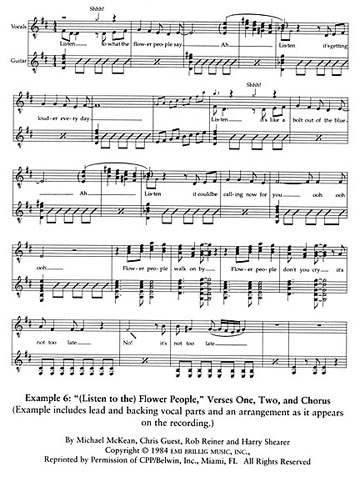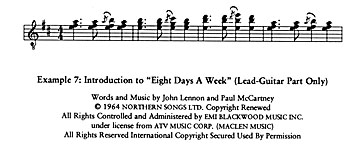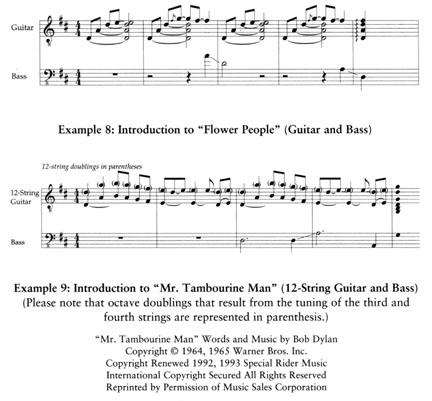 home // store // text
files
// multimedia // discography // a
to zed
// random
// links
home // store // text
files
// multimedia // discography // a
to zed
// random
// links
 In “Heavy Duty,”
the obvious incongruity between styles accounts largely for the
humorous effect of the tune. In “Cups and Cakes,” those
characteristics that are congruent within the style and those
which are incongruent enter into a dialectical relationship.
The Spinal Tap number “(Listen to the) Flower People,”
however, elicits an amused response in a way slightly different
from the two preceding examples. We are to believe that “Flower
People” was released in 1967, perhaps during the celebrated
“summer of love.” The tune begins with a six-measure
introduction that features electric-guitar arpeggiation around
a D-major chord. Two eight-bar verses are followed by an eight-measure
chorus (see Example 6). In “Heavy Duty,”
the obvious incongruity between styles accounts largely for the
humorous effect of the tune. In “Cups and Cakes,” those
characteristics that are congruent within the style and those
which are incongruent enter into a dialectical relationship.
The Spinal Tap number “(Listen to the) Flower People,”
however, elicits an amused response in a way slightly different
from the two preceding examples. We are to believe that “Flower
People” was released in 1967, perhaps during the celebrated
“summer of love.” The tune begins with a six-measure
introduction that features electric-guitar arpeggiation around
a D-major chord. Two eight-bar verses are followed by an eight-measure
chorus (see Example 6).

 Next there is an instrumental
interlude of fifteen bars. Two eight-measure verses follow, played
as before except that two beats are inserted between bars four
and five of the first verse. The music from the instrumental
interlude is used as the basis for a psychedelic-style ending.
There are some fairly obvious gags in this song: the use of the
famous theme to Mozart’s Eine
Kleine Nachtmusik at the words “it’s like a Mozart
symphony” in verse three produces an obvious interstylistic
incongruity (this is, of course, similar to the appearance of
the Boccherini minuet in “Heavy Duty,” discussed previously).
The whispered “shhh” after each occurrence of the word
“listen” in the text and the phase-shifted “no”
after “it’s not too late” are exaggerations of
stylistically typical vocal effects. [31] Next there is an instrumental
interlude of fifteen bars. Two eight-measure verses follow, played
as before except that two beats are inserted between bars four
and five of the first verse. The music from the instrumental
interlude is used as the basis for a psychedelic-style ending.
There are some fairly obvious gags in this song: the use of the
famous theme to Mozart’s Eine
Kleine Nachtmusik at the words “it’s like a Mozart
symphony” in verse three produces an obvious interstylistic
incongruity (this is, of course, similar to the appearance of
the Boccherini minuet in “Heavy Duty,” discussed previously).
The whispered “shhh” after each occurrence of the word
“listen” in the text and the phase-shifted “no”
after “it’s not too late” are exaggerations of
stylistically typical vocal effects. [31]
 “(Listen to the) Flower
People,” like “Cups and Cakes,” is in the British-invasion
style. “Flower People,” in addition, relies heavily
on stylistic traits usually associated with “psychedelic
rock”; but this stylistic mixture is also typical of late
British-invasion pop. “Flower People” has many of the
typical psychedelic features: reversed-tape effects, exotic scales
(the ending especially), and the use of sitar. [32] Figure 2 shows a table of correspondences
for “Flower People.” [33] “(Listen to the) Flower
People,” like “Cups and Cakes,” is in the British-invasion
style. “Flower People,” in addition, relies heavily
on stylistic traits usually associated with “psychedelic
rock”; but this stylistic mixture is also typical of late
British-invasion pop. “Flower People” has many of the
typical psychedelic features: reversed-tape effects, exotic scales
(the ending especially), and the use of sitar. [32] Figure 2 shows a table of correspondences
for “Flower People.” [33]

While “Flower People” has many of the general features
of late British-invasion music, it also models features of certain
specific tunes rather closely. The harmonic progression of the
verse (see Figure 3) is I-II-iv-I.

Consider the Beatles’ 1965 hit “Eight Days a Week”
which progresses I-II-IV-I, or their 1966 hit “Nowhere Man”
which moves I-V-IV-I-ii-iv-I. “Flower People” can be
seen as a conflation of those two. Further, “Eight Days
a Week” features the guitar introduction shown in Example
7. The introduction to “Flower People,” while much
simpler, is nevertheless similar.

 The introduction to “Flower
People” bears an even stronger resemblance to the opening
of the Byrds’ 1965 hit “Mr. Tambourine Man” (Examples
8/9). [34] The introduction to “Flower
People” bears an even stronger resemblance to the opening
of the Byrds’ 1965 hit “Mr. Tambourine Man” (Examples
8/9). [34]

 While the Byrds’ Roger
McGuinn uses his characteristic Rickenbacker electric twelve-string
and the Spinal Tap introduction does not, the voicings, and the
guitar fingerings that go with them, are very similar. The similarity
between the introductions to “Mr. Tambourine Man” and
“(Listen to the) Flower People” is further reinforced
by the similar electric bass guitar parts that accompany each.
Further, the musical texture employed in both tunes after the
introduction consists of chords arpeggiated on the twelve-string
low on the neck against a second guitar that articulates short,
rhythmic high voicings (see Figure 4). “Flower People”
demonstrates a closer kind of modeling than either “Heavy
Duty” or “Cups and Cakes.” While the Byrds’ Roger
McGuinn uses his characteristic Rickenbacker electric twelve-string
and the Spinal Tap introduction does not, the voicings, and the
guitar fingerings that go with them, are very similar. The similarity
between the introductions to “Mr. Tambourine Man” and
“(Listen to the) Flower People” is further reinforced
by the similar electric bass guitar parts that accompany each.
Further, the musical texture employed in both tunes after the
introduction consists of chords arpeggiated on the twelve-string
low on the neck against a second guitar that articulates short,
rhythmic high voicings (see Figure 4). “Flower People”
demonstrates a closer kind of modeling than either “Heavy
Duty” or “Cups and Cakes.”

Despite these many close correspondences, though, there is
something about “Flower People” that keeps it from
being mistaken for an authentic example of either British-invasion
pop or psychedelic rock. And it is precisely this stylistic “near
miss” that elicits the amused response.
 In his 1981 book, Sound Effects,
sociologist Simon Frith distinguishes between pop and rock. [35] Pop music is made with
the consumer in mind: it is commercially motivated and aims to
give the listeners “what they want.” Rock, on the other
hand, lays claim to authenticity and sincerity: the musician
expresses him- or herself without regard for commercial gain.
Frith points out that most rock musicians reside somewhere in
between these opposite poles. Frith’s book provides a clear
(and accurate) description of these contradictory pressures.
[36] But anybody who
has ever taken rock music seriously will not need to read Frith’s
elegant prose to understand the meaning of “selling out.”
In fact, the desire to play a music that has a high degree of
integrity, and the desire to make some kind of living through
doing so, come to seem irreconcilable to many rock musicians;
some quit, some sell out, and some get jobs teaching music theory
or musicology. Some rock musicians are able to strike a balance
between the pursuit of their musical goals and the demands of
the music industry, at times achieving notable commercial success. In his 1981 book, Sound Effects,
sociologist Simon Frith distinguishes between pop and rock. [35] Pop music is made with
the consumer in mind: it is commercially motivated and aims to
give the listeners “what they want.” Rock, on the other
hand, lays claim to authenticity and sincerity: the musician
expresses him- or herself without regard for commercial gain.
Frith points out that most rock musicians reside somewhere in
between these opposite poles. Frith’s book provides a clear
(and accurate) description of these contradictory pressures.
[36] But anybody who
has ever taken rock music seriously will not need to read Frith’s
elegant prose to understand the meaning of “selling out.”
In fact, the desire to play a music that has a high degree of
integrity, and the desire to make some kind of living through
doing so, come to seem irreconcilable to many rock musicians;
some quit, some sell out, and some get jobs teaching music theory
or musicology. Some rock musicians are able to strike a balance
between the pursuit of their musical goals and the demands of
the music industry, at times achieving notable commercial success.
 What makes “(Listen to
the) Flower People” not fit the British-invasion / psychedelic-rock
mold, what makes it seem not quite right, is this: “Flower
People” is a sell out, and the stylistically competent listener
can discern this. To use Frith’s distinction, it is all
pop and no rock. It arouses an amused response because it tries
every stylistic trick in the book in an effort to be current,
and in 1967 current means psychedelic. But psychedelia was the
voice of the counterculture, a culture that advocated “peace,
love, and dope.” Psychedelic music was high in commitment
to the ideals of the “flower people movement” —
or was at least perceived to be so — and the rock pole eclipsed
the pop one in this music — or, again, was at least supposed
to. What makes “(Listen to
the) Flower People” not fit the British-invasion / psychedelic-rock
mold, what makes it seem not quite right, is this: “Flower
People” is a sell out, and the stylistically competent listener
can discern this. To use Frith’s distinction, it is all
pop and no rock. It arouses an amused response because it tries
every stylistic trick in the book in an effort to be current,
and in 1967 current means psychedelic. But psychedelia was the
voice of the counterculture, a culture that advocated “peace,
love, and dope.” Psychedelic music was high in commitment
to the ideals of the “flower people movement” —
or was at least perceived to be so — and the rock pole eclipsed
the pop one in this music — or, again, was at least supposed
to.
 Into this context comes Spinal
Tap, which is presumably looking for a hit single in the United
States and “flower power” is “in.” In order
not to offend, however, they attenuate the elements in the music
that might be considered objectionable. There is a kind of stylistic
neutralization that takes place — a sort of entertainment-business
“spiffing up” that makes the tune acceptable to parents
everywhere. The liner notes to the soundtrack LP inform us that
“Flower People” is the single from Spinal Tap’s
1967 LP “Spinal Tap Sings ‘Listen to the Flower People’
and Other Favorites.” [37]
In a 1984 interview published in Guitar Player magazine, Nigel
Tufnel reflects on Spinal Tap’s 1967 hit: Into this context comes Spinal
Tap, which is presumably looking for a hit single in the United
States and “flower power” is “in.” In order
not to offend, however, they attenuate the elements in the music
that might be considered objectionable. There is a kind of stylistic
neutralization that takes place — a sort of entertainment-business
“spiffing up” that makes the tune acceptable to parents
everywhere. The liner notes to the soundtrack LP inform us that
“Flower People” is the single from Spinal Tap’s
1967 LP “Spinal Tap Sings ‘Listen to the Flower People’
and Other Favorites.” [37]
In a 1984 interview published in Guitar Player magazine, Nigel
Tufnel reflects on Spinal Tap’s 1967 hit:
 Interviewer:
In 1967 you did “(Listen To The) Flower People,” which
seems like a complete departure. Why? Interviewer:
In 1967 you did “(Listen To The) Flower People,” which
seems like a complete departure. Why?
 Tufnel: Well, to be honest
— and only because I like you I’m telling you —
we tried to jump on the bandwagon. There was such an enormous
sort of public clamoring for that sort of garbage, frankly, we
thought we might as well reap some of the benefits. So we dished
that one out, and it really did well for us, actually. [38] Tufnel: Well, to be honest
— and only because I like you I’m telling you —
we tried to jump on the bandwagon. There was such an enormous
sort of public clamoring for that sort of garbage, frankly, we
thought we might as well reap some of the benefits. So we dished
that one out, and it really did well for us, actually. [38]
 The broadest amused response
to “Flower People,” then, is aroused by challenging
the listener’s stylistic competency for British-invasion
and early psychedelic-rock music. “Flower People” is
so close to the real thing that it could easily pass for authentic.
One does notice the incongruity of the psychedelic features with
their pop application. But unlike “Heavy Duty,” stylistic
juxtaposition alone is not enough to mark “Flower People”
as a satire; there are genuine tunes that mix these stylistic
features. To return to Scruton, the listener is amused only upon
recognition that some particular stylistic incongruity is an
exaggeration; we say: “This couldn’t be real!”
It is not so much the presence of psychedelic features in a tune
that is directed at a broad pop audience that triggers the humor,
as much as it is that the use of these features is a little heavy-handed
and desperate. Spinal Tap goes a little too far — they are
perhaps too eager to please — and the listener realizes
that the incongruity is too great to be genuine. The humor then
ultimately lies in issues of stylistic authenticity, or in the
blatant lack of it. The broadest amused response
to “Flower People,” then, is aroused by challenging
the listener’s stylistic competency for British-invasion
and early psychedelic-rock music. “Flower People” is
so close to the real thing that it could easily pass for authentic.
One does notice the incongruity of the psychedelic features with
their pop application. But unlike “Heavy Duty,” stylistic
juxtaposition alone is not enough to mark “Flower People”
as a satire; there are genuine tunes that mix these stylistic
features. To return to Scruton, the listener is amused only upon
recognition that some particular stylistic incongruity is an
exaggeration; we say: “This couldn’t be real!”
It is not so much the presence of psychedelic features in a tune
that is directed at a broad pop audience that triggers the humor,
as much as it is that the use of these features is a little heavy-handed
and desperate. Spinal Tap goes a little too far — they are
perhaps too eager to please — and the listener realizes
that the incongruity is too great to be genuine. The humor then
ultimately lies in issues of stylistic authenticity, or in the
blatant lack of it.
read
more >>>>>>
 [31]
. In Herman’s Hermits’ 1967 hit, “There’s
a Kind of Hush,” the word is sung “hushhh.” See
Greatest Hits. [31]
. In Herman’s Hermits’ 1967 hit, “There’s
a Kind of Hush,” the word is sung “hushhh.” See
Greatest Hits.
 [32] . In this instance a “Coral Sitar”
is used, an instrument manufactured by the Danelectro Company
that sounds somewhat like a sitar but is tuned like a guitar.
For more on the psychedelic movement and the groups that played
psychedelic music, see Ward, Stokes, and Tucker, Rock of Ages,
328-87. [32] . In this instance a “Coral Sitar”
is used, an instrument manufactured by the Danelectro Company
that sounds somewhat like a sitar but is tuned like a guitar.
For more on the psychedelic movement and the groups that played
psychedelic music, see Ward, Stokes, and Tucker, Rock of Ages,
328-87.
 [33] . Another example — an obscure one, to be
sure — that makes use of some of the psychedelic features
discussed here is a tune by the British psychedelic band “Tomorrow”;
it is their 1967 British hit “My White Bicycle,” which
appears on the group’s LP Tomorrow (Import
Records, Inc./EMI Records Ltd., IMP 1003, 1968). Here one notes
the reverse-tape effects, exotic-scale guitar passages, simple-minded
lyrics, and whispered back-up vocals. The lead guitarist in this
recording is Steve Howe. Howe, as a member of the British supergroup
Yes, went on to be an extremely influential figure on the Seventies
progressive-rock music scene. Howe is certainly the target of
the backstage scene in This is Spinal Tap in which lead-guitarist
Nigel Tufnel leads film maker Martin DiBergi through his dozens
of collectible guitars. The Yes group becomes one target of Spinal
Tap’s progressive rock send-up numbers — pieces entitled
“Stonehenge” and “Rock and Roll Creation.” [33] . Another example — an obscure one, to be
sure — that makes use of some of the psychedelic features
discussed here is a tune by the British psychedelic band “Tomorrow”;
it is their 1967 British hit “My White Bicycle,” which
appears on the group’s LP Tomorrow (Import
Records, Inc./EMI Records Ltd., IMP 1003, 1968). Here one notes
the reverse-tape effects, exotic-scale guitar passages, simple-minded
lyrics, and whispered back-up vocals. The lead guitarist in this
recording is Steve Howe. Howe, as a member of the British supergroup
Yes, went on to be an extremely influential figure on the Seventies
progressive-rock music scene. Howe is certainly the target of
the backstage scene in This is Spinal Tap in which lead-guitarist
Nigel Tufnel leads film maker Martin DiBergi through his dozens
of collectible guitars. The Yes group becomes one target of Spinal
Tap’s progressive rock send-up numbers — pieces entitled
“Stonehenge” and “Rock and Roll Creation.”
 [34] . It should be pointed out that the Los Angeles-based
Byrds cannot be considered British invasion, but are usually
thought to be part of the “American response.” For
a discussion of the American response, see Ward, Stokes, and
Tucker, Rock of Ages, 303-14. For a fuller consideration of the
Byrds, see Johnny Rogan, Timeless Flight: The Definitive Biography
of the Byrds, 2nd ed. (Essex: Square One Books, 1990). [34] . It should be pointed out that the Los Angeles-based
Byrds cannot be considered British invasion, but are usually
thought to be part of the “American response.” For
a discussion of the American response, see Ward, Stokes, and
Tucker, Rock of Ages, 303-14. For a fuller consideration of the
Byrds, see Johnny Rogan, Timeless Flight: The Definitive Biography
of the Byrds, 2nd ed. (Essex: Square One Books, 1990).
 [35] . Simon Frith, Sound Effects: Youth, Leisure,
and the Politics of Rock and Roll (New York: Pantheon Books,
1981), 11. [35] . Simon Frith, Sound Effects: Youth, Leisure,
and the Politics of Rock and Roll (New York: Pantheon Books,
1981), 11.
 [36] . In his Studying Popular
Music (Milton Keynes: Open University Press, 1990), Richard
Middleton cautions that a simple binary opposition like the pop-rock
one presented here can be misleading (43). It is clearly possible
that the artist who builds a career on the directness and authenticity
of his or her music may be just as likely to be manipulating
this image — or have it manipulated by a manager or record
company — for commercial gain as the most cynical pop star.
In using Frith’s distinction in the present discussion,
however, I am less concerned with the reality of whether artists
are really what they appear to be, than with the notion that
listeners perceive authenticity in musical, and specifically
stylistic, terms. The idea is that in absence of any other information,
the competent listener can hear the artist either “selling
out” or remaining faithful. [36] . In his Studying Popular
Music (Milton Keynes: Open University Press, 1990), Richard
Middleton cautions that a simple binary opposition like the pop-rock
one presented here can be misleading (43). It is clearly possible
that the artist who builds a career on the directness and authenticity
of his or her music may be just as likely to be manipulating
this image — or have it manipulated by a manager or record
company — for commercial gain as the most cynical pop star.
In using Frith’s distinction in the present discussion,
however, I am less concerned with the reality of whether artists
are really what they appear to be, than with the notion that
listeners perceive authenticity in musical, and specifically
stylistic, terms. The idea is that in absence of any other information,
the competent listener can hear the artist either “selling
out” or remaining faithful.
 [37] . Liner notes to Spinal Tap, Spinal Tap. [37] . Liner notes to Spinal Tap, Spinal Tap.
 [38] . Nigel Tufnel, “Volume For Volume’s
Sake: Nigel Tufnel of Spinal Tap,” interview by Teisco Del
Ray, Guitar Player 18/10 (October, 1984): 43. [38] . Nigel Tufnel, “Volume For Volume’s
Sake: Nigel Tufnel of Spinal Tap,” interview by Teisco Del
Ray, Guitar Player 18/10 (October, 1984): 43.
|